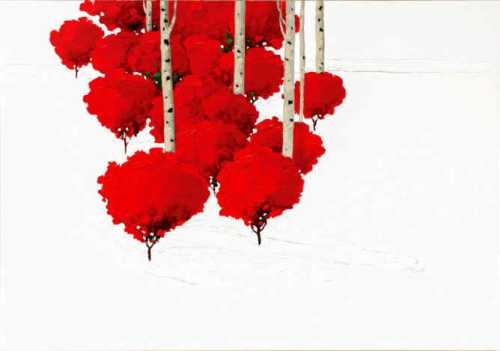About Arman Yaghoobpour
Arman Yaghoobpour is widely recognized for his engagement with landscape painting. A lecturer, researcher, and modernist painter, he was born in the city of Borujerd. He earned a bachelor's degree in painting from the Faculty of Fine Arts at the University of Tehran, followed by a master's and Ph.D. in Art Research from Tarbiat Modares University. He later joined the academic staff of the School of Art in Neyshabur. In 2013, Yaghoobpour held his first solo exhibition at Golestan Gallery, where he was also named the gallery’s best-selling artist that year. His second solo show, titled "Matrix," was held a year later in collaboration with the Mahe-Mehr Gallery. Since then, his work has been exhibited frequently in both solo and group exhibitions across galleries in Tehran and other cities.
Yaghoobpour is best known for his landscapes. His preferred subjects include natural scenery—such as green meadows and rows of poplar trees—as well as rural textures, like adobe-domed houses. The defining element of his work lies in his tactile approach to paint: he applies color in thick impastos, layering heavy masses of pigment side by side. This treatment of paint aligns with one of the central achievements of modernist painting—emphasizing the materiality of paint as a subject in its own right. Manouchehr Yektai was among the first Iranian artists to explore this potential, and his influence on Yaghoobpour’s painting is clearly discernible. It appears not only in the physicality of the brushwork but also in the tilted perspective that brings depth toward the surface of the canvas, the triangular compositions, the minimalist sensibility, and the dominance of white paint and raw canvas.
Trees and landscapes form the core of Yaghoobpour’s visual universe. When asked why depictions of trees remain unique despite their prevalence in painting, he responded: "The answer lies in your question. Each of these works has its own unique charm. Everyone depicts the tree from their own worldview. In Davood Emdadian’s works, the tree represents the grandeur and dignity of nature, while in Hossein Mahjoubi’s paintings, it conveys an ideal world. It is the artist’s mind that brings meaning. The tree is merely a pretext—through its branches, we ascend into the artist’s world."
Regarding the visual sources for his work, Yaghoobpour explains: "Many of my paintings are imaginative, but this imagination is shaped by images of nature stored in memory. Sometimes they may recall a specific place, but my goal is not to represent a particular site with objective accuracy."
The Most Expensive Artwork
At Auctions
First Attendance
11 January 2019
# Attendance
11
# Artworks
11
Average Realized Price
5,156 USD
Average Min Estimate
2,594 USD
Average Max Estimate
3,641 USD
Sell-through Rate
100%
Average Growth of Artwork Worth
76.915%
Timeline
In The Shade Of The Sky exhibition
12 December
580 Nanometers / Yellow exhibition
28 November
Nature in Transit exhibition
24 October
CHARSOO- Part 2 exhibition
3 October
Charsoo exhibition
5 September
Tehran Online Show exhibition
18 July
Tehran exhibition
18 July
The 23rd Tehran - Modern and Contemporary Iranian Art auction
22 May
Garden exhibition
7 March
Renewed exhibition
7 March
Landscape Plateau exhibition
13 December
A Tree-Rich Garden exhibition
15 November
A Selection of Works by Iranian Contemporary Artists 3 exhibition
18 October
The 21st Tehran - Contemporary Iranian Art auction
11 October
Resize exhibition
16 August
Darrous, 34 exhibition
2 August
The 20th Tehran- Modern and Contemporary Iranian Art auction
5 July
Artibition Auction - March 2024 auction
11 March
Spring of Art exhibition
1 March
Spring, Summer, Fall, Winter .... and Spring exhibition
5 January
Collector - Modern exhibition
29 September
The VenoArt National Loving Day auction
11 June
resize exhibition
13 April
Recovery/ The third series exhibition
10 March
Collector exhibition
15 February
We exhibition
24 November
Lotfi x Mashahir Cross 2 exhibition
9 September
Art Closer Than Ever exhibition
26 August
Tehran- 16th- Iranian contemporary art auction
1 July
Arman Yaghoubpour Online Painting Exhibition exhibition
13 May
Nowruz Festival of Rivers exhibition
10 March
Archive 2 exhibition
25 February
Last Chapter exhibition
25 February
Adobe and Plain exhibition
24 December
Painter/City/Building exhibition
15 October
Har Dam Az In Baagh exhibition
2 July
Small Artworks collection exhibition
11 June
Sakoo 1400 exhibition
21 May
The 13th Tehran- Modern and Contemporary Iranian Art auction
15 January
No.8 auction
1 January
No.6 auction
16 October
Archive exhibition
21 August
Show and Sell of Works for the Benefit of Corona Patients exhibition
24 April
Frame 50 exhibition
21 February
5th Collector exhibition
24 January
دوازدهمین دوره حراج تهران auction
17 January
White Black Gray exhibition
13 December
Rangaab exhibition
13 December
Painting Exhibition By Arman Yaghoub Pour exhibition
22 February
دهمین دوره حراج تهران auction
11 January
Summer Sale of Artibition exhibition
7 September
Painting Exhibition by Arman Yaghoub Pour exhibition
20 October
The Discourse of Colors exhibition
15 September
Exhibition of paintings by Arman Yaghoubpour exhibition
5 May
Arman Yaghoubpour Artworks exhibition
4 November
Exhibition of paintings by Arman Yaghoubpour exhibition
14 February
Articles
Iranian Art Market Report for the Year 1401 SH 15 May 2023
When the Art Hall team was looking for the Iranian artworks' sales records for art appraisal, felt the void of an authoritative art reference. That's why Artchart was born in 2019. The purpose of launching Artchart was to create a database of the Iranian art market that can be used as a reference for a wide range of people, from artists to art collectors. Now Artchart has collected...

